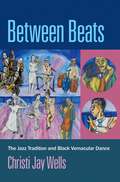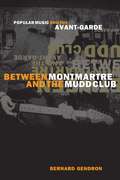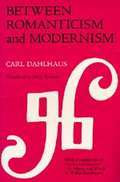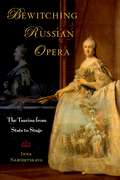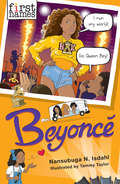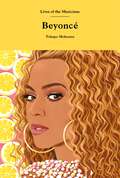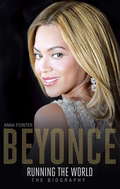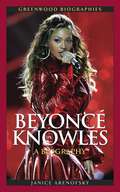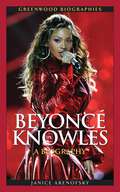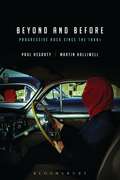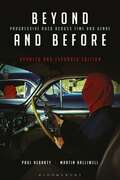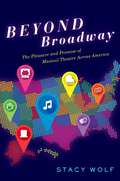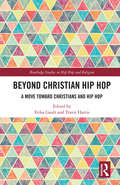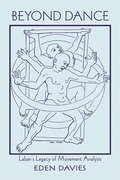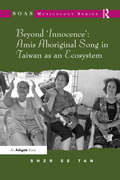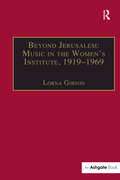- Table View
- List View
Between Beats: The Jazz Tradition and Black Vernacular Dance
by Christi Jay WellsBetween Beats: The Jazz Tradition and Black Vernacular Dance offers a new look at the complex intersections between jazz music and popular dance over the last hundred-plus years. Author Christi Jay Wells shows how popular entertainment and cultures of social dancing were crucial to jazz music's formation and development even as jazz music came to earn a reputation as a "legitimate" art form better suited for still, seated listening. Through the concept of choreographies of listening, the book explores amateur and professional jazz dancers' relationships with jazz music and musicians as jazz's soundscapes and choreoscapes were forged through close contact and mutual creative exchange. It also unpacks the aesthetic and political negotiations through which jazz music supposedly distanced itself from dancing bodies. Fusing little-discussed material from diverse historical and contemporary sources with the author's own years of experience as a social jazz dancer, it advances participatory dance and embodied practice as central topics of analysis in jazz studies. As it explores the fascinating history of jazz as popular dance music, it exposes how American anxieties about bodies and a broad cultural privileging of the cerebral over the corporeal have shaped efforts to "elevate" expressive forms such as jazz to elite status.
Between Montmartre and the Mudd Club: Popular Music and the Avant-Garde
by Bernard GendronDuring the late nineteenth and early twentieth century, popular music was considered nothing but vulgar entertainment. Today, jazz and rock music are seen as forms of art, and their practitioners are regularly accorded a status on par with the cultural and political elite. To take just one recent example, Bono, lead singer and lyricist of the rock band U2, got equal and sometimes higher billing than Pope John Paul II on their shared efforts in the Jubilee 2000 debt-relief project. When and how did popular music earn so much cultural capital? To find out, Bernard Gendron investigates five key historical moments when popular music and avant-garde art transgressed the rigid boundaries separating high and low culture to form friendly alliances. He begins at the end of the nineteenth century in Paris's Montmartre district, where cabarets showcased popular music alongside poetry readings in spaces decorated with modernist art works. Two decades later, Parisian poets and musicians "slumming" in jazz clubs assimilated jazz's aesthetics in their performances and compositions. In the bebop revolution in mid-1940s America, jazz returned the compliment by absorbing modernist devices and postures, in effect transforming itself into an avant-garde art form. Mid-1960s rock music, under the leadership of the Beatles, went from being reviled as vulgar music to being acclaimed as a cutting-edge art form. Finally, Gendron takes us to the Mudd Club in the late 1970s, where New York punk and new wave rockers were setting the aesthetic agenda for a new generation of artists. Between Montmartre and the Mudd Club should be on the shelves of anyone interested in the intersections between high and low culture, art and music, or history and aesthetics.
Between Montmartre and the Mudd Club: Popular Music and the Avant-Garde
by Bernard GendronDuring the late nineteenth and early twentieth century, popular music was considered nothing but vulgar entertainment. Today, jazz and rock music are seen as forms of art, and their practitioners are regularly accorded a status on par with the cultural and political elite. To take just one recent example, Bono, lead singer and lyricist of the rock band U2, got equal and sometimes higher billing than Pope John Paul II on their shared efforts in the Jubilee 2000 debt-relief project. When and how did popular music earn so much cultural capital? To find out, Bernard Gendron investigates five key historical moments when popular music and avant-garde art transgressed the rigid boundaries separating high and low culture to form friendly alliances. He begins at the end of the nineteenth century in Paris's Montmartre district, where cabarets showcased popular music alongside poetry readings in spaces decorated with modernist art works. Two decades later, Parisian poets and musicians "slumming" in jazz clubs assimilated jazz's aesthetics in their performances and compositions. In the bebop revolution in mid-1940s America, jazz returned the compliment by absorbing modernist devices and postures, in effect transforming itself into an avant-garde art form. Mid-1960s rock music, under the leadership of the Beatles, went from being reviled as vulgar music to being acclaimed as a cutting-edge art form. Finally, Gendron takes us to the Mudd Club in the late 1970s, where New York punk and new wave rockers were setting the aesthetic agenda for a new generation of artists. Between Montmartre and the Mudd Club should be on the shelves of anyone interested in the intersections between high and low culture, art and music, or history and aesthetics.
Between Romanticism and Modernism: Four Studies in the Music of the Later Nineteenth Century (California Studies In 19th-century Music #1)
by Carl Dahlhaus Mary WhittallCarl Dahlhaus here treats Nietzsche's youthful analysis of the contradictions in Wagner's doctrine (and, more generally, in romantic musical aesthetics); the question of periodicization in romantic and neo-romantic music; the underlying kinship between Brahms's and Wagner's responses to the central musical problems of their time; and the true significance of musical nationalism. Included in this volume is Walter Kauffman's translation of the previously unpublished fragment, "On Music and Words," by the young Nietzsche.
Bewitching Russian Opera: The Tsarina from State to Stage
by Inna NaroditskayaIn Bewitching Russian Opera: The Tsarina from State to Stage, author Inna Naroditskaya investigates the musical lives of four female monarchs who ruled Russia for most of the eighteenth century: Catherine I, Anna, Elizabeth, and Catherine the Great. Engaging with ethnomusicological, historical, and philological approaches, her study traces the tsarinas' deeply invested interest in musical drama, as each built theaters, established drama schools, commissioned operas and ballets, and themselves wrote and produced musical plays. Naroditskaya examines the creative output of the tsarinas across the contexts in which they worked and lived, revealing significant connections between their personal creative aspirations and contemporary musical-theatrical practices, and the political and state affairs conducted during their reigns. Through contemporary performance theory, she demonstrates how the opportunity for role-playing and costume-changing in performative spaces allowed individuals to cross otherwise rigid boundaries of class and gender. A close look at a series of operas and musical theater productions--from Catherine the Great's fairy tale operas to Tchaikovsky's Pique Dame--illuminates the transition of these royal women from powerful political and cultural figures during their own reigns, to a marginalized and unreal Other under the patriarchal dominance of the subsequent period. These tsarinas successfully fostered the concept of a modern nation and collective national identity, only to then have their power and influence undone in Russian cultural consciousness through the fairy-tales operas of the 19th century that positioned tsarinas as "magical" and dangerous figures rightfully displaced and conquered--by triumphant heroes on the stage, and by the new patriarchal rulers in the state. Ultimately, this book demonstrates that the theater served as an experimental space for these imperial women, in which they rehearsed, probed, and formulated gender and class roles, and performed on the musical stage political ambitions and international conquests which they would later enact on the world stage itself.
BEWITCHING RUSSIAN OPERA C: The Tsarina from State to Stage
by Inna NaroditskayaIn Bewitching Russian Opera: The Tsarina from State to Stage, author Inna Naroditskaya investigates the musical lives of four female monarchs who ruled Russia for most of the eighteenth century: Catherine I, Anna, Elizabeth, and Catherine the Great. Engaging with ethnomusicological, historical, and philological approaches, her study traces the tsarinas' deeply invested interest in musical drama, as each built theaters, established drama schools, commissioned operas and ballets, and themselves wrote and produced musical plays. Naroditskaya examines the creative output of the tsarinas across the contexts in which they worked and lived, revealing significant connections between their personal creative aspirations and contemporary musical-theatrical practices, and the political and state affairs conducted during their reigns. Through contemporary performance theory, she demonstrates how the opportunity for role-playing and costume-changing in performative spaces allowed individuals to cross otherwise rigid boundaries of class and gender. A close look at a series of operas and musical theater productions--from Catherine the Great's fairy tale operas to Tchaikovsky's Pique Dame--illuminates the transition of these royal women from powerful political and cultural figures during their own reigns, to a marginalized and unreal Other under the patriarchal dominance of the subsequent period. These tsarinas successfully fostered the concept of a modern nation and collective national identity, only to then have their power and influence undone in Russian cultural consciousness through the fairy-tales operas of the 19th century that positioned tsarinas as "magical" and dangerous figures rightfully displaced and conquered--by triumphant heroes on the stage, and by the new patriarchal rulers in the state. Ultimately, this book demonstrates that the theater served as an experimental space for these imperial women, in which they rehearsed, probed, and formulated gender and class roles, and performed on the musical stage political ambitions and international conquests which they would later enact on the world stage itself.
BEYONCÉ (First Names)
by Nansubuga IsdahlTrue life stories of the most amazing people EVER!Meet Beyoncé Knowles-Carter, the mega-talented singer, songwriter, producer, dancer and movie star, whose music has thrilled millions around the world, smashed records and won her award after award.Find out:Why she used to think she looked like Dumbo the elephant;How she turned an insult into a best-selling single;And why she threw a $25,000 pair of earrings into the audience.Get to know BEYONCÉ on First Name terms.
Beyoncé (Lives of the Musicians)
by Tshepo MokoenaBeyoncé is not simply a pop sensation. She is a cultural phenomenon empowering the oppressed and dispossessed, challenging white privilege and misogyny and exploding gender politics. But who is Beyoncé Knowles-Carter? And how did a small girl from Houston become the strong confident woman whose albums sell in their millions and whose songs have become anthems against racial and sexual discrimination and oppression? This biography sets out to reveal exactly that.
Beyoncé: The Biography
by Anna Pointer'Everything you ever wanted to know about the world's biggest singing star.' 5* - BestBeyoncé: Running The World is the full story of Houston born-and-bred Beyoncé's extraordinary life, which saw her join her first pop group at the age of nine before fronting the girl band Destiny's Child - the biggest-selling female group of all time. After embarking on a solo career in 2003, Beyoncé's status as a superstar was sealed and to date she has won more than 220 awards internationally and the hearts of millions of fans the world over. The most definitive and up-to-date telling of Beyoncé's story ever written, this book provides an intimate close-up on both her professional and personal life, with the inside story on how she and rapper husband Jay-Z became the biggest power couple on earth. With reports that their marriage was crumbling before the world's eyes on their 2014 joint tour, On The Run, it pieces together the split rumours that plagued them at every turn and documents exactly how they coped with such intense public scrutiny.The book also analyses Beyoncé's role as a mother to young daughter Blue Ivy and explores the hidden heartbreaks of her past, including a tragic miscarriage, a lengthy battle with depression and an agonising rift with her manager father Mathew.While celebrating Beyoncé's greatest triumphs Beyoncé: Running The World uncovers the truth behind the headlines, finding out exactly who 'Queen Bey' is and what really goes on behind the scenes...Contains an extra chapter with the most up-to-date information on the world's biggest star.
Beyoncé Knowles: A Biography (Greenwood Biographies)
by Janice ArenofskyAlthough Beyoncé Knowles is not yet 30, the sensual superstar has already succeeded on many levels: as a dancer, singer, composer, model, music producer, video director and actress. Like rap star/entrepreneur Jay-Z, with whom Beyoncé recently married, she has evolved into a businesswoman, who with her designer-mother, Tina Knowles, markets Beyoncé's personal fashion line, House of Dereon. The multi-talented, global entertainer lends her name and image to many commercial and philanthropic ventures. She is the spokeswoman for L'Oreal and appears in ads for Pepsi and Ford.This biography tells the story of a young, talented woman's meteoric rise in the entertainment industry. From a shy, demure Catholic schoolgirl growing up in Houston, Texas, Beyoncé Knowles eventually morphed into the first African-American woman to win the Songwriter of the Year Award from the American Society of Composers, Authors and Publishers Pop Music Awards. The once-shy suburban schoolgirl has gone far beyond her original dream of becoming a first-rate musician and vocalist. With the assistance of her manager-father—former Xerox executive Mathew Knowles—and as lead singer of the R&B girl group Destiny's Child (the world's all-time bestselling female group), Beyoncé has won 10 Grammy Awards and two Golden Globe nominations. Her albums have reached more than 20 million people worldwide, and she has become a cultural icon to music lovers everywhere as well as a role model for young women. Author Janice Arenofsky gives students and general readers alike an insightful look at a music and fashion icon who has a unique niche in popular culture today. Complete with photos, a timeline, and a thorough bibliography.
Beyoncé Knowles: A Biography (Greenwood Biographies)
by Janice ArenofskyAlthough Beyoncé Knowles is not yet 30, the sensual superstar has already succeeded on many levels: as a dancer, singer, composer, model, music producer, video director and actress. Like rap star/entrepreneur Jay-Z, with whom Beyoncé recently married, she has evolved into a businesswoman, who with her designer-mother, Tina Knowles, markets Beyoncé's personal fashion line, House of Dereon. The multi-talented, global entertainer lends her name and image to many commercial and philanthropic ventures. She is the spokeswoman for L'Oreal and appears in ads for Pepsi and Ford.This biography tells the story of a young, talented woman's meteoric rise in the entertainment industry. From a shy, demure Catholic schoolgirl growing up in Houston, Texas, Beyoncé Knowles eventually morphed into the first African-American woman to win the Songwriter of the Year Award from the American Society of Composers, Authors and Publishers Pop Music Awards. The once-shy suburban schoolgirl has gone far beyond her original dream of becoming a first-rate musician and vocalist. With the assistance of her manager-father—former Xerox executive Mathew Knowles—and as lead singer of the R&B girl group Destiny's Child (the world's all-time bestselling female group), Beyoncé has won 10 Grammy Awards and two Golden Globe nominations. Her albums have reached more than 20 million people worldwide, and she has become a cultural icon to music lovers everywhere as well as a role model for young women. Author Janice Arenofsky gives students and general readers alike an insightful look at a music and fashion icon who has a unique niche in popular culture today. Complete with photos, a timeline, and a thorough bibliography.
Beyond and Before: Progressive Rock since the 1960s (Arden Critical Companions)
by Martin Halliwell Paul HegartyA brilliant new survey and intelligent exploration of progressive rock, from its origins through to contemporary artists. Nicely illustrated, it includes rare photos of artists like Kate Bush and Genesis.
Beyond and Before: Progressive Rock since the 1960s (Arden Critical Companions)
by Martin Halliwell Paul HegartyA brilliant new survey and intelligent exploration of progressive rock, from its origins through to contemporary artists. Nicely illustrated, it includes rare photos of artists like Kate Bush and Genesis.
Beyond and Before, Updated and Expanded Edition: Progressive Rock Across Time and Genre
by Paul Hegarty Martin HalliwellThe original edition of Beyond and Before extends an understanding of “progressive rock” by providing a fuller definition of what progressive rock is, was and can be. Called by Record Collector “the most accomplished critical overview yet” of progressive rock and one of their 2011 books of the year, Beyond and Before moves away from the limited consensus that prog rock is exclusively English in origin and that it was destroyed by the advent of punk in 1976. Instead, by tracing its multiple origins and complex transitions, it argues for the integration of jazz and folk into progressive rock and the extension of prog in Kate Bush, Radiohead, Porcupine Tree and many more. This 10-year anniversary revised edition continues to further unpack definitions of progressive rock and includes a brand new chapter focusing on post-conceptual trends in the 2010s through to the contemporary moment. The new edition discusses the complex creativity of progressive metal and folk in greater depth, as well as new fusions of genre that move across global cultures and that rework the extended form and mission of progressive rock, including in recent pop concept albums. All chapters are revised to keep the process of rethinking progressive rock alive and vibrant as a hybrid, open form.
Beyond and Before, Updated and Expanded Edition: Progressive Rock Across Time and Genre
by Paul Hegarty Martin HalliwellThe original edition of Beyond and Before extends an understanding of “progressive rock” by providing a fuller definition of what progressive rock is, was and can be. Called by Record Collector “the most accomplished critical overview yet” of progressive rock and one of their 2011 books of the year, Beyond and Before moves away from the limited consensus that prog rock is exclusively English in origin and that it was destroyed by the advent of punk in 1976. Instead, by tracing its multiple origins and complex transitions, it argues for the integration of jazz and folk into progressive rock and the extension of prog in Kate Bush, Radiohead, Porcupine Tree and many more. This 10-year anniversary revised edition continues to further unpack definitions of progressive rock and includes a brand new chapter focusing on post-conceptual trends in the 2010s through to the contemporary moment. The new edition discusses the complex creativity of progressive metal and folk in greater depth, as well as new fusions of genre that move across global cultures and that rework the extended form and mission of progressive rock, including in recent pop concept albums. All chapters are revised to keep the process of rethinking progressive rock alive and vibrant as a hybrid, open form.
Beyond Broadway: The Pleasure and Promise of Musical Theatre Across America
by Professor Stacy WolfThe idea of American musical theatre often conjures up images of bright lights and big city, but its lifeblood is found in amateur productions at high schools, community theatres, afterschool programs, summer camps, and dinner theatres. In Beyond Broadway, author Stacy Wolf looks at the widespread presence and persistence of musical theatre in U.S. culture, and examines it as a social practice--a live, visceral experience of creating, watching, and listening. Why does local musical theatre flourish in America? Why do so many Americans continue to passionately engage in a century-old artistic practice that requires intense, person-to-person collaboration? And why do audiences still flock to musicals in their hometowns? Touring American elementary schools, a middle school performance festival, afterschool programs, high schools, summer camps, state park outdoor theatres, community theatres, and dinner theatres from California to Tennessee, Wolf illustrates musical theatre's abundance and longevity in the U.S. as a thriving social activity that touches millions of lives.
BEYOND BROADWAY C: The Pleasure and Promise of Musical Theatre Across America
by Professor Stacy WolfThe idea of American musical theatre often conjures up images of bright lights and big city, but its lifeblood is found in amateur productions at high schools, community theatres, afterschool programs, summer camps, and dinner theatres. In Beyond Broadway, author Stacy Wolf looks at the widespread presence and persistence of musical theatre in U.S. culture, and examines it as a social practice--a live, visceral experience of creating, watching, and listening. Why does local musical theatre flourish in America? Why do so many Americans continue to passionately engage in a century-old artistic practice that requires intense, person-to-person collaboration? And why do audiences still flock to musicals in their hometowns? Touring American elementary schools, a middle school performance festival, afterschool programs, high schools, summer camps, state park outdoor theatres, community theatres, and dinner theatres from California to Tennessee, Wolf illustrates musical theatre's abundance and longevity in the U.S. as a thriving social activity that touches millions of lives.
Beyond Christian Hip Hop: A Move Towards Christians and Hip Hop (Routledge Studies in Hip Hop and Religion)
by Erika D. Gault Travis HarrisChristians and Christianity have been central to Hip Hop since its inception. This book explores the intersection of Christians and Hip Hop and the multiple outcomes of this intersection. It lays out the ways in which Christians and Hip Hop overlap and diverge. The intersection of Christians and Hip Hop brings together African diasporic cultures, lives, memories and worldviews. Moving beyond the focus on rappers and so-called "Christian Hip Hop," each chapter explores three major themes of the book: identifying Hip Hop, irreconcilable Christianity, and boundaries.There is a self-identified Christian Hip Hop (CHH) community that has received some scholarly attention. At the same time, scholars have analyzed Christianity and Hip Hop without focusing on the self-identified community. This book brings these various conversations together and show, through these three themes, the complexities of the intersection of Christians and Hip Hop. Hip Hop is more than rap music, it is an African diasporic phenomenon. These three themes elucidate the many characteristics of the intersection between Christians and Hip Hop and our reasoning for going beyond "Christian Hip Hop." This collection is a multi-faceted view of how religious belief plays a role in Hip Hoppas' lives and community. It will, therefore, be of great interest to scholars of Religion and Hip Hop, Hip Hop, African Diasporas, Religion and the Arts, Religion and Race and Black Theology as well as Religious Studies more generally.
Beyond Christian Hip Hop: A Move Towards Christians and Hip Hop (Routledge Studies in Hip Hop and Religion)
by Erika D. Gault Travis HarrisChristians and Christianity have been central to Hip Hop since its inception. This book explores the intersection of Christians and Hip Hop and the multiple outcomes of this intersection. It lays out the ways in which Christians and Hip Hop overlap and diverge. The intersection of Christians and Hip Hop brings together African diasporic cultures, lives, memories and worldviews. Moving beyond the focus on rappers and so-called "Christian Hip Hop," each chapter explores three major themes of the book: identifying Hip Hop, irreconcilable Christianity, and boundaries.There is a self-identified Christian Hip Hop (CHH) community that has received some scholarly attention. At the same time, scholars have analyzed Christianity and Hip Hop without focusing on the self-identified community. This book brings these various conversations together and show, through these three themes, the complexities of the intersection of Christians and Hip Hop. Hip Hop is more than rap music, it is an African diasporic phenomenon. These three themes elucidate the many characteristics of the intersection between Christians and Hip Hop and our reasoning for going beyond "Christian Hip Hop." This collection is a multi-faceted view of how religious belief plays a role in Hip Hoppas' lives and community. It will, therefore, be of great interest to scholars of Religion and Hip Hop, Hip Hop, African Diasporas, Religion and the Arts, Religion and Race and Black Theology as well as Religious Studies more generally.
Beyond Dance: Laban's Legacy of Movement Analysis
by Eden DaviesBeyond Dance: Laban's Legacy of Movement Analysis offers students of dance and movement a brief introduction to the life and work of Rudolf Laban, and how this work has been extended into the fields of movement therapy, communications, early childhood development, and other fields. While many dance students know of Laban and his work as it applies to their field, few know the full story of how this technique has developed and grown. For many who enter into the fields of dance movement therapy, performance, and communications, there are valuable lessons to be learned from Laban and his follower's works. Beyond Dance offers a concise introduction to this world. Refreshingly free of jargon and easy to understand, the work offers dance students – and others interested in human movement – a full picture of the many possibilities inherent in Laban's theories. For many who will pursue careers 'beyond dance', this work will be a useful guidebook into related areas. This will be ideally suited to students of Laban movement theory in dance and movement therapy, and will be used in advanced courses in these areas as useful, brief introduction to the field.
Beyond Dance: Laban's Legacy of Movement Analysis
by Eden DaviesBeyond Dance: Laban's Legacy of Movement Analysis offers students of dance and movement a brief introduction to the life and work of Rudolf Laban, and how this work has been extended into the fields of movement therapy, communications, early childhood development, and other fields. While many dance students know of Laban and his work as it applies to their field, few know the full story of how this technique has developed and grown. For many who enter into the fields of dance movement therapy, performance, and communications, there are valuable lessons to be learned from Laban and his follower's works. Beyond Dance offers a concise introduction to this world. Refreshingly free of jargon and easy to understand, the work offers dance students – and others interested in human movement – a full picture of the many possibilities inherent in Laban's theories. For many who will pursue careers 'beyond dance', this work will be a useful guidebook into related areas. This will be ideally suited to students of Laban movement theory in dance and movement therapy, and will be used in advanced courses in these areas as useful, brief introduction to the field.
Beyond 'Innocence': Amis Aboriginal Song in Taiwan as an Ecosystem
by ShzrEe TanTaiwan aboriginal song has received extensive media coverage since the launch and settlement of a copyright lawsuit following pop group Enigma's allegedly unauthorized use of Amis voices in the 1996 Olympics hit, Return To Innocence. Taking as her starting point the ripple effects of this case, Shzr Ee Tan explores the relationship of this song culture to contemporary Amis society. She presents Amis song in its multiple manifestations as an ecosystem, symbiotic components of which interact and feed back upon one another in cross-cutting platforms of village life, festival celebration, cultural performance, popular song, art music and Christian hymnody. Tan's investigation hinges upon drawing a conceptual line between ladhiw, the Amis term for 'song' - a word vested with connotations of life-force, tradition, ritual and taboo - and the foreign term of yinyue ('music' - borrowed from Mandarin). This difference forms the basis of how Amis song is (re)constructed through processes of modernization, Christianization and politico-economic change. A single Amis melody, for example, can exist in several guises that are contextually exclusive but functionally mutually-supportive. Thus, a weeding song (ladhiw), which may have lost its traditional context of existence following advancements in farming technology, becomes sustained within a larger ecosystem, finding new life on the interacting platforms of Amis Catholic hymnody, karaoke and tourist shows. The latter genres (collectively, yinyue) may not rely on traditional livelihoods for survival, but thrive on a traditional melody's deeper associations to local memory and idealized Amis identities. While these new and old genres are stylistically separate, they feed into each other and back into themselves - through transforming contexts and cross-referenced memes - in organic and developing cycles of song activity. Drawing from fieldwork conducted from 2000-2010 as well as a background in ethnomusicology and journalism, Ta
Beyond 'Innocence': Amis Aboriginal Song in Taiwan as an Ecosystem
by ShzrEe TanTaiwan aboriginal song has received extensive media coverage since the launch and settlement of a copyright lawsuit following pop group Enigma's allegedly unauthorized use of Amis voices in the 1996 Olympics hit, Return To Innocence. Taking as her starting point the ripple effects of this case, Shzr Ee Tan explores the relationship of this song culture to contemporary Amis society. She presents Amis song in its multiple manifestations as an ecosystem, symbiotic components of which interact and feed back upon one another in cross-cutting platforms of village life, festival celebration, cultural performance, popular song, art music and Christian hymnody. Tan's investigation hinges upon drawing a conceptual line between ladhiw, the Amis term for 'song' - a word vested with connotations of life-force, tradition, ritual and taboo - and the foreign term of yinyue ('music' - borrowed from Mandarin). This difference forms the basis of how Amis song is (re)constructed through processes of modernization, Christianization and politico-economic change. A single Amis melody, for example, can exist in several guises that are contextually exclusive but functionally mutually-supportive. Thus, a weeding song (ladhiw), which may have lost its traditional context of existence following advancements in farming technology, becomes sustained within a larger ecosystem, finding new life on the interacting platforms of Amis Catholic hymnody, karaoke and tourist shows. The latter genres (collectively, yinyue) may not rely on traditional livelihoods for survival, but thrive on a traditional melody's deeper associations to local memory and idealized Amis identities. While these new and old genres are stylistically separate, they feed into each other and back into themselves - through transforming contexts and cross-referenced memes - in organic and developing cycles of song activity. Drawing from fieldwork conducted from 2000-2010 as well as a background in ethnomusicology and journalism, Ta
Beyond Jerusalem: Music in the Women's Institute, 1919-1969
by Lorna GibsonMusic in the Women's Institute has become stereotyped by the ritualistic singing of Jerusalem at monthly meetings. Indeed, Jerusalem has had an important role within the organization, and provides a valuable means within which to assess the organization's relationship with women's suffrage and the importance of rurality in the Women's Institute's identity. However, this book looks beyond Jerusalem by examining the full range of music making within the organization and locates its significance within a wider historical-cultural context. The Institute's promotion of conducting - a regular part of its musical activity since the 1930s - is discussed within the context of embodying overtly feminist sentiments. Lorna Gibson concludes that a redefinition of the term 'feminism' is needed and the concept of 'gendered spheres' of conducting provides a useful means of understanding the Institute's policy. The organization's promotion of folk song is also examined and reveals the Institute's contribution to the Folk Revival, as well as providing a valuable context within which to understand the National Federation's first music commission, Ralph Vaughan Williams's Folk Songs of the Four Seasons (1950). This work, and the Institute's second commission, Malcolm Williamson's The Brilliant and the Dark (1969), are examined with the context of the organization's music policy. In addition to discussing the background to the works, issues of critical reception are addressed. The book concludes with an Epilogue about the National Society Choir (later known as the Avalon Singers), which tested the organization's commitment to amateur music making. The book is the result of meticulous work undertaken in the archives of the National Federation, the BBC Written Archives Centre, the V&A archives, the Britten-Pears Library, the Ralph Vaughan Williams Library, the Women's Library and the Newspaper Library.
Beyond Jerusalem: Music in the Women's Institute, 1919-1969
by Lorna GibsonMusic in the Women's Institute has become stereotyped by the ritualistic singing of Jerusalem at monthly meetings. Indeed, Jerusalem has had an important role within the organization, and provides a valuable means within which to assess the organization's relationship with women's suffrage and the importance of rurality in the Women's Institute's identity. However, this book looks beyond Jerusalem by examining the full range of music making within the organization and locates its significance within a wider historical-cultural context. The Institute's promotion of conducting - a regular part of its musical activity since the 1930s - is discussed within the context of embodying overtly feminist sentiments. Lorna Gibson concludes that a redefinition of the term 'feminism' is needed and the concept of 'gendered spheres' of conducting provides a useful means of understanding the Institute's policy. The organization's promotion of folk song is also examined and reveals the Institute's contribution to the Folk Revival, as well as providing a valuable context within which to understand the National Federation's first music commission, Ralph Vaughan Williams's Folk Songs of the Four Seasons (1950). This work, and the Institute's second commission, Malcolm Williamson's The Brilliant and the Dark (1969), are examined with the context of the organization's music policy. In addition to discussing the background to the works, issues of critical reception are addressed. The book concludes with an Epilogue about the National Society Choir (later known as the Avalon Singers), which tested the organization's commitment to amateur music making. The book is the result of meticulous work undertaken in the archives of the National Federation, the BBC Written Archives Centre, the V&A archives, the Britten-Pears Library, the Ralph Vaughan Williams Library, the Women's Library and the Newspaper Library.
